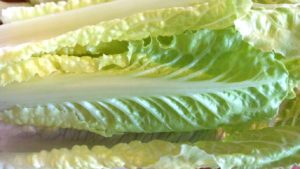Consumers and Retailers Urged to Dump Yuma-Grown Romaine Lettuce
 For the second time in less than six months, romaine contaminated with E. coli O157:H7 is leading to a wide-scale call to dump the lettuce. In this case, the Centers of Disease Control (CDC) is issuing the recommendation, which focuses on chopped romaine grown in Yuma, AZ.
For the second time in less than six months, romaine contaminated with E. coli O157:H7 is leading to a wide-scale call to dump the lettuce. In this case, the Centers of Disease Control (CDC) is issuing the recommendation, which focuses on chopped romaine grown in Yuma, AZ.
The CDC is reporting that there have been 35 confirmed cases of E. coli O157:H7, with 22 of those cases requiring hospitalization. Those cases fall within 11 states, mostly in the Northeast and Midwest. Cases have also been reported in Idaho and Washington. No deaths have been reported so far, although there are three cases of kidney failure.
This is an active outbreak, with 18 more people in nine states being confirmed as having illnesses related to E. coli in from a CDC report on April 10, 2018, and an update on April 13.
Although no specific distributor, processor, or grower can currently be identified, 26 of 28 people interviewed so far reported consuming romaine lettuce in the week before their illness started, the FDA reports.
“Most people reported eating a salad at a restaurant, and romaine lettuce was the only common ingredient identified among the salads eaten. The restaurants reported using bagged, chopped romaine lettuce to make salads. At this time, ill people are not reporting whole heads or hearts of romaine,” the report states.
The previous, fatal E. coli in romaine lettuce incident was in late December 2017 and early January 2018, and the Canadian government issued a recall. In the U.S., Consumer Reports recommended a ban on romaine, but the CDC and FDA never made an official recall. In that instance, the reported cases were early enough at the time of the Canadian recall that the romaine at fault was already out of the supply chain.
Grocery stores, restaurants, and other fresh produce outlets are urged to not sell any chopped romaine lettuce from Yuma, AZ. If the source is not obvious, they are urged to ask their suppliers about the source.
Consumers are urged to throw away any store-bought chopped romaine lettuce, including salad mixes, that is already in their homes. They are urged to confirm the source of any romaine served in restaurants, and to look for where their salad mixes originated when shopping at the grocery story.
In a joint statement, several vegetable industry associations say they are working with authorities to identify the source of the contaminated lettuce.
“The leafy greens community takes the responsibility for producing fresh produce very seriously. Leafy greens food-safety programs in both California and Arizona are the most rigorous in today’s produce industry. Both programs include mandatory farm food safety practices, and frequent government audits to ensure those practices are being followed,” the statement reads.
It was issued by Produce Marketing Association, Arizona Leafy Greens Marketing Agreement, California Leafy Greens Marketing Agreement, United Fresh, and Western Growers.










